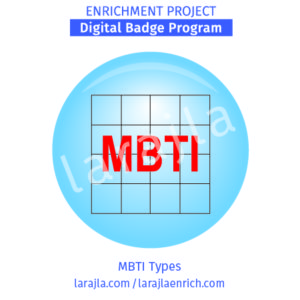
Knowing what your personality type is can help you realize your strengths and weaknesses. The Myers Briggs Type Indicator identifies sixteen different personality types. Learn more about the MBTI and try it.
Steps
1. Why.
I always thought there was something wrong with me. In school, the other girls talked make-up and clothes. I wanted to play Dungeons and Dragons, explore the woods and read . . . a lot. It was suggested to me to take the MBTI. After identifying my personality type, a lot of the things I’ve done make sense. Not everything fits, but it has given me some insight into myself. When someone drives me crazy, I know why and I can take steps to minimize my reactions. When I start obsessive behavior, I can identify it . . . and try to minimize it.
I’m sure you have your own questions as to why you do the things you do. The MBTI can give you answers. Learn about the MBTI.
NOTE: No personality test is 100% accurate. Each person is unique. If you choose to try a personality test, take those items you identify within yourself and examine who you are and how you can improve your life and interactions with others.
2. Where.
You can do it the official way and have someone coach you through the answers you receive after taking the test. You can also take it online for free and learn a lot that way. Start by doing the test online for free.
3. You.
Your results will vary if you take it more than once. I’m not saying you’ll jump from one dichotomy to the next, but you’ll shift within your area. After taking the test and getting a result, read about your personality type. Pick out those items that are true for you. Question any that you think aren’t you.
4. Examples.
Find others who are your MBTI type. Are you similar or different from them? Also check out Pinterest to see a slew of items related to your type.
5. Review.
Explore those preferences that you identify with. Are there steps you can take to make you aware of certain quirks or reactions you have? Can you use the information you’ve gained to improve your life and interactions? Note down those things you would like to improve about yourself as a reminder of who you are and what you’re working to achieve.
Below, we’ll go over the pairs that make up your preferences or “dichotomies” to get you on the path to understanding.
Preferences
6. Introvert.
Introverts are drained by interacting with groups of people and outward situations. Leading the Brownie Girl Scout troop for two hours after school would result in an evening of my not wanting to talk to anyone. I called it “spending the evening playing with my toes.” Being alone charged me back up. I’ve also found that the weekend trainings that I love are stressful for me after the first day. Carpooling is a bad idea as well as I need that alone time to mentally prepare myself before work and to start to decompress afterwards.
Are you an introvert? If so, you’ll need to plan alone time in your life to give you time to reenergize yourself. Learn more about introversion.
7. Extravert.
Are you the life of the party? Do you get energized by being in a large group? If so, you may find being alone is stressful and draining. You probably prefer being on the go, directing your energy to deal with people and situations. Learn more about extraversion.
8. Intuition.
Intuition is one of the ways you perceive the world. This is how you understand and interpret the world. If you believe in “gut feelings”, you’re more likely to be intuitive. You want information more than just from sensing. You trust information from your knowledge as well as your imagination. You tend to look for patterns. You want the meaning behind the facts. Learn about intuition.
9. Sensing.
The second way to perceive the world is to sense it. You “sense” details and facts. It’s all about the external sources. The information used to perceive the world needs to be tangible and concrete. You want the facts, not the unreliable hunches that can’t be substantiated. Learn about sensing.
10. Feeling.
Feeling is one way you make decisions. It is easier for you to associate with others and be empathetic. You consider others feelings as well as the people involved. Values are important. Explore how feelings can be used as a way to judge a situation and others.
11. Thinking.
The opposite of feeling is thinking. You’re more concerned with the truth and strive to be objective. You may be seen as cold because of your detachment from a situation so you can make “rational” decisions. You want to know the “why.” Explore how thinking can be used to judge a situation and others.
12. Perceiving.
Perceiving and judging (next step) are the lifestyle pair. Your perception changes depending on the other items you tested for above. Overall, you want the world to be open and flexible. You want to “go with the flow.” Learn more about perception
13. Judging.
Judging is the second lifestyle preference. Just like perception, your “judging” is dependent on your other results. You prefer your world view to be organized and planned out. Learn more about judging.
Badge and Supplement Files
Member Level
- EP_Badge List_MBTI Types_larajla — list of badge items
- EP_Supp_List_MBTI Types_larajla — list of supplements for the badge
- SUPP_BPG_MBTI Types_2in_12up_larajla — generic badge printable
- SUPP_MBTI Types_Journal_larajla — badge journal
- SUPP_MBTI Types_Planner_larajla — badge planner
Supplement Fun
- N/A
Sites to Explore
- www.myersbriggs.org/my-mbti-personality-type
- en.wikipedia.org/wiki/Myers%E2%80%93Briggs_Type_Indicator
- www.betterhelp.com/advice/general/you-can-take-the-myers-briggs-personality-test-free-on-these-websites
- www.16personalities.com/personality-types
- www.teamtechnology.co.uk/tt/t-articl/mb-simpl.htm
- www.sitepoint.com/what-the-myers-briggs-personality-test-can-and-cant-tell-you
- thoughtcatalog.com/tag/myers-briggs
Get the infographic here > larajla blog post
Get the PDFs of the badge program / supplements here